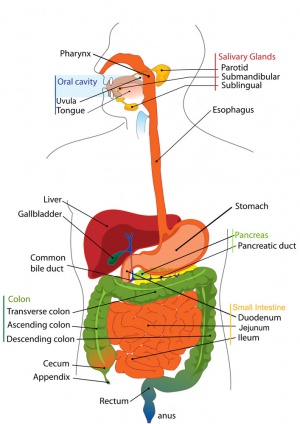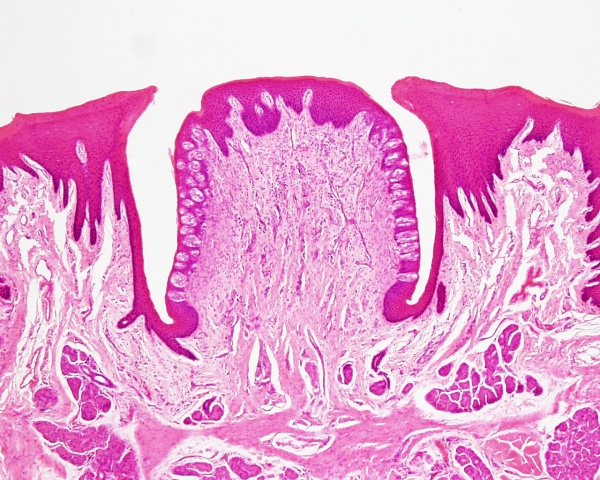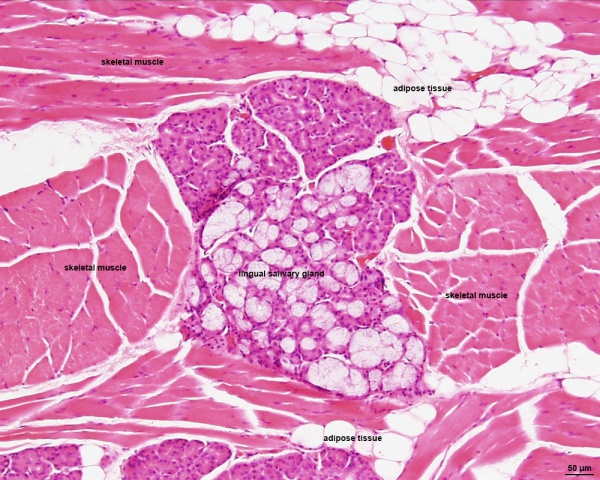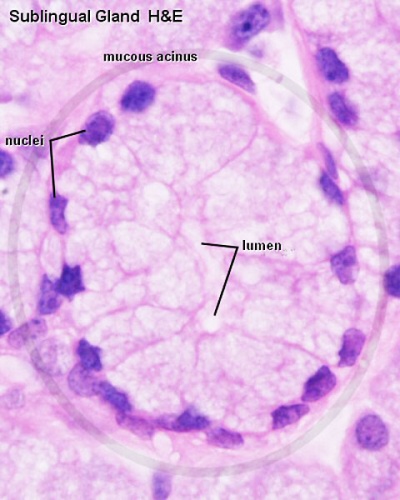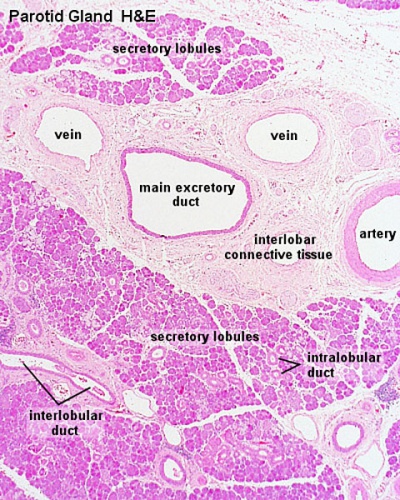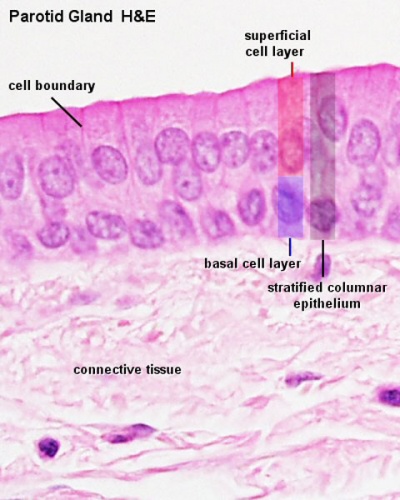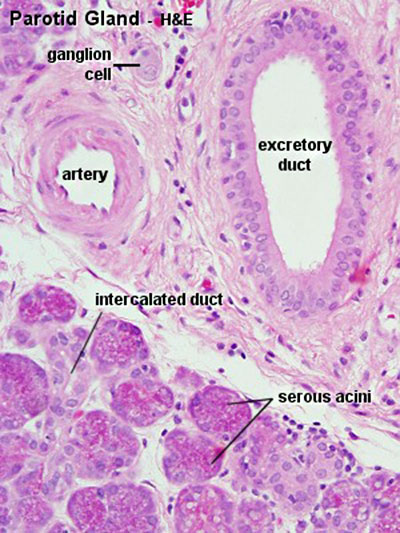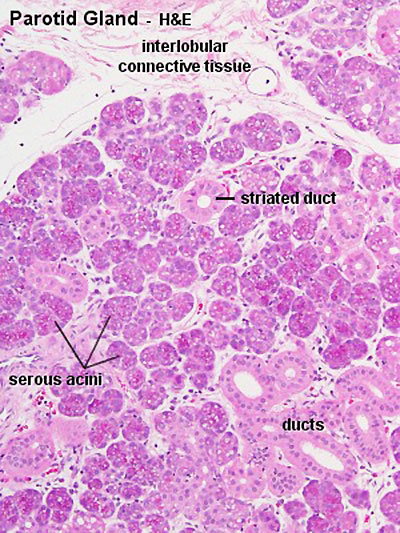Salivary Gland Development
Introduction
Root of Tongue
It shows interlacing striated muscle fibres, lingual tonsils with lymphatic nodules, crypts, mucoserous glands, and ducts of the glands (some mucous acini have serous demilunes). Tongue: circumvallate papillae Taste buds in the lateral wall of circumvallate papillae; von Ebner's serous glands and ducts; striated muscle fascicles; blood vessels; nerve fascicles; lymph aggregations.
Circumvallate Papilla
Human Tongue ( lingual salivary gland, white adipose tissue, skeletal muscle)
Submandibular gland
Mixed salivary gland; predominantly serous acini; some mucous acini with serous demilunes; interlobular ducts with stratified cuboidal or stratified columnar epithelium; connective tissue; striated ducts with simple cuboidal lining epithelium; short intercalated ducts.
Sublingual gland
Predominantly mucous acini; some serous demilunes; interlobular ducts with stratified cuboidal/columnar epithelium; connective tissue; striated ducts with simple columnar lining epithelium; short intercalated ducts.
Parotid gland
Serous salivary gland; lobules; connective tissue septa; serous acini, zymogen granules; striated ducts; interlobular ducts with stratified epithelium; intercalated ducts; lymph node with capsule.
Terms
- Histology Glossary: A | B | C | D | E | F | G | H | I | J | K | L | M | N | O | P | Q | R | S | T | U | V | W | X | Y | Z | ANAT2241 Support | Histology | Histology Stains | Embryology Glossary
Abbreviations: ( ) plural form in brackets, A. Arabic, abb. abbreviation, c. circa =about, F. French adj. adjective, G. Greek, Ge. German, cf. compare, L. Latin, dim. diminutive, NA. Nomina anatomica, q.v. which see, OF. Old French
- acinus (-i) - L. = a juicy berry, a grape; applied to small, rounded terminal secretory units of compound exocrine glands that have a small lumen (adj. acinar).
- adventitia - layer of loose connective tissue, separates alimentary canal from other tissues.
- Auerbach plexus - Auerbach, Leopold (1828-1897) Breslau neuropathologist & anatomist; Auerbach's nerve plexus in external muscle layer of intestinal wall (1862).
- Brunner gland - Brunner, Johann Konrad (1653-1727) Professor of Medince at Heidelberg; B's glands = compound mucus-secreting glands of duodenal submucosa (1687).
- buccal - L. bucca = cheek; related to cheek or mouth.
- chief cell - (peptic cell, gastric zymogenic cell) gastric cells that release pepsinogen, gastric lipase and chymosin.
- circumvallate papillae - (vallate papillae) tongue largest and least numerous papillae (human 8 to 12) occur in depressions of the surface of the tongue and are surrounded with a trench formed by the infolding of the epithelium. Taste buds are numerous on the lateral surfaces of these papillae and the excretory ducts of serous glands (glands of von Ebner) open into the trenches surrounding the papillae.
- demilune - L. dimidius = half + luna = moon; crescent-shaped cap of serous cells over mucous alveolus in some salivary glands.
- ductus (-us) - L. = passage from L. ducere = to lead; tube lined by epithelium for exocrine glandular secretions to reach surface.
- fundus - L. = bottom, base (as in fundamental); refers to region of organ (e.g., stomach, uterus, eye), gland (e.g., gastric glands).
- filiform papillae - tongue smallest and most numerous papillae, provide a rough surface to aid in the manipulation and processing of foods.
- fungiform - L. fungus = mushroom + forma = a shape; of lingual papillae.
- fungiform papillae - tongue single evenly spaced between the filiform papillae. Epithelium is slightly thinner than on the remaining surface of the tongue and connective tissue core is richly vascularised.
- gastric - adj. L. gastricus , from G. gaster = stomach, belly; relating to the stomach.
- gland - L. glandula , dim of L. glans = an acorn, a pellet; term used to describe mesenteric lymph nodes (Herophilus, c. 300 BC).
- intercalated - L. inter = between + calare = to proclaim, calatus = inserted; of a duct inserted between the end of the gland (acinus, or alveolus) and a larger duct.
- intercalated duct - cuboidal epithelium, modify saliva, add bicarbonate ions (buffering) and absorb chloride.
- intramural - L. intra = within + murus = wall; within the wall of an organ.
- labial - adj. L. labialis = of the lips, L. labium = lip, rim of a vessel.
- lacteal - L. lac = milk ( lacteus = of milk, lactare = to suckle); intestinal lymphatic, containing chyle after a fatty meal.
- lining epithelium - non-keratinised stratified squamous epithelium, covers the remaining (non-masticatory epithelium) surfaces of the oral cavity.
- lingual - adj. L. lingua = tongue.
- lips - outside (lined by skin) and inside (oral mucosa), vermilion border (prolabium) transition from the skin to the oral mucosa, forms only small part of the anatomical lips.
- lumen - L. = light; space enclosed by tubular or vesicular structure; hence luminal.
- masticatory epithelium - covers the tongue, gingivae and hard palate. Keratinised epithelium to different degrees depending on the extent of physical forces exerted on the epithelium.
- microvilli - epithelial cell apical surface specialisation seen in the small intestinal. These microfilament filled structures increase the surface area for absorption and secretion.
- mucin - L. mucus from G. muxa = snot, slime; protein constituent of all mucus; occurs as granules in secretory cells.
- mucosa - (-ae) L. = mucous membrane.
- muscularis externa - in oesophagus contains striated muscle (upper third), a mixture of striated muscle and smooth muscle (middle third) and smooth muscle (lower third).
- mucus - L. = slime (adj. mucous).
- myenteric - G. mys = muscle + enteron = intestine (cf. Auerbach).
- oesophagus - G. oiso = future of phero = I carry + pahgein = to eat; G. oisophagos = gullet, or tube carrying food from pharynx to stomach.
- oesophageal glands - located in the submucosa produce a mucous secretion, which lubricates the epithelium and aids the passage of food. Oesophagus closest to the stomach may also be mucosal mucus-producing glands, similar to the glands in the adjacent mucosa of the stomach.
- oral - adj. L. os, oris = mouth.
- oxyntic cell - see parietal cell.
- palate - L. palatum = roof of mouth.
- palisade - L. palus = stake; like a fence of stakes.
- Paneth cell - Paneth, Josef (1857-1890) Breslau & Vienna physiologist; P. cells (1887) = eosinophilic cells at base of intestinal crypts of Lieberkühn.
- papilla - (-ae) L. = a teat, a nipple; a nipple-like projection, e.g., on the tonge (Malpighi, c. 1670; cf. circumvallate, filiform, foliate, fungiform, vallate); duodenal papilla (containing duodenal ampulla).
- parietal cell - (oxyntic cell, delomorphous cell), gastric epithelial cell that secretes gastric acid (HCl) and intrinsic factor.
- parotid - G. para = beside + otos = of the ear; a salivary gland.
- pepsinogen - G. pepis = digestion + gennan = to produce; a precusor of pepsin = enzyme that aids digestion.
- peptic cell - see chief cell.
- plica - (-ae) a corruption from L. plicare = to fold; in13th century a scalp infection endemic in Poland was called plica polonica (Polish plait); any kind of fold.
- plicae circulares - L. = circular folds; actually transverse folds that are not circular in small intestine = valves of Kerckring, q.v.
- ruga - (-ae) L. = a fold or wrinkle, e.g., in stomach.
- sac - L. saccus = sack, bag, from G. sakkos .
- salivary - L. saliva = spittle.
- secretion - L. secretus = separated; production of materials by glandular activity.
- serous - adj. L. = having nature of serum, watery fluid.
- stomach - G. stomachos = gullet or oesophagus, from G. stoma = a mouth + cheo = I pour; lower end of the gullet; organ attached to lower end. NB. Greeks used gaster for stomach.
- striated border - L. striatus = striped; light microscopic term for the fine microvilli on intestinal absorptive cells.
- striated ducts - modifies saliva (secretion of potassium and the absorption of sodium), columnar cells with the nucleus of located approximately midways between the apical and basal cell surfaces. Striations are found in the basal part of the cytoplasm of the cells, where numerous mitochondria are found between infoldings of the basal cell membrane. These cells can also take up a secretable form of antibodies and release them into the saliva.
- submandibular - adj. L. " + mandibula = jaw.
- succus entericus - L. = juice + of the intestine.
- succus gastricus - L. = juice + of the stomach.
- tongue muscles - skeletal muscle organized into strands oriented more or less perpendicular to each other.
- tongue nerves - movement (XII, hypoglossal nerve - motor) and sensory information. (V, trigeminal nerve - sensory - anterior two-thirds; VII, facial nerve - taste; IX, glossopharyngeal nerve - sensory/taste - posterior one-third).
- tonsil - L. tonsilla (origin obscure); mass of lymphocytes close to an epithelium, e.g., lingual tonsil, palatine tonsil (the "tonsil"), pharyngeal tonsil (adenoid, tonsil of Luschka, q.v.), tubal tonsil (of auditory tube).
- tubuloacinar gland - secretory acini with the first part of the duct system also participating in the secretory process.
- uvula - L. = a little grape; pendulous posterior end of soft palate used to produce gutteral consonants (1695).
- vallate papillae - see circumvallate papillae.
- von Ebner's glands - serous glands associated with circumvallate papillae, their ducts open into the trenches surrounding the papillae ("rinsing glands").
- Waldeyer's ring - Waldeyer, Heinrich Wilhelm Gottfried (1836-1921) Brelau & Berlin anatomist; ring of lymphatic tissue at junction of oro- and nasopharynx (1884).
- zymogenic - adj. G. zyme = leaven, ferment, sour dough + gennan = to produce; of the granules in glandular cells producing enzymes.
- zymogenic cell - see chief cell.
Cite this page: Hill, M.A. (2024, April 26) Embryology Salivary Gland Development. Retrieved from https://embryology.med.unsw.edu.au/embryology/index.php/Salivary_Gland_Development
- © Dr Mark Hill 2024, UNSW Embryology ISBN: 978 0 7334 2609 4 - UNSW CRICOS Provider Code No. 00098G
